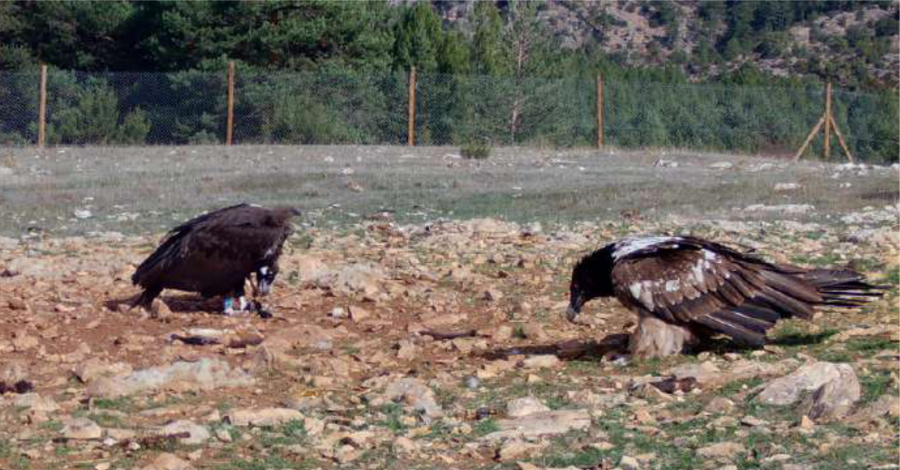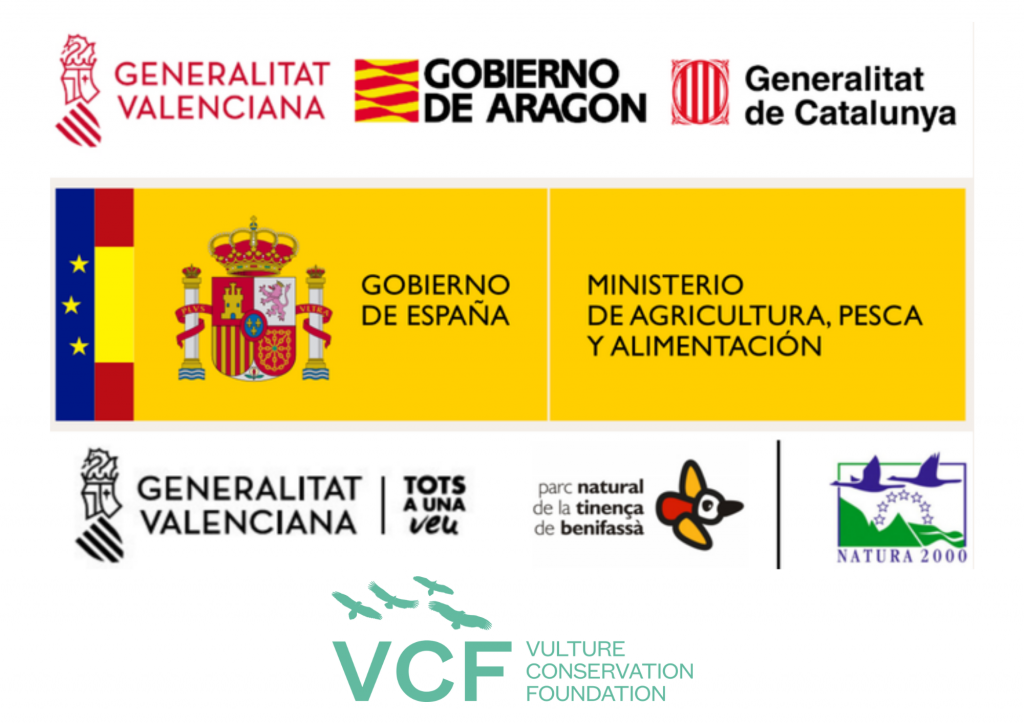
The project to bring the Bearded Vulture back to Maestrazgo is making good progress and the most recently released birds are adapting well. Today, we share with you the story of Ereta and Espèrit and some of the latest project updates.
Ereta and Espèrit, the latest Bearded Vultures released
Following the reintroduction efforts in Maestrazgo on 17 May 2022, Parc Natural de la Tinença de Benifassà welcomed two new Bearded Vultures coming from captivity. The two young hatched in captivity within the Bearded Vulture Captive Breeding Network, coordinated by us at the Vulture Conservation Foundation (VCF) on behalf of EAZA’s EEP (Bearded Vulture EEP). The female, Ereta, came from our Bearded Vulture captive breeding centre of Guadalentín (Jaen) and the male, Espèrit, hatched at the Richard Faust Zentrum Specialised Breeding Centre (RFZ) in Austria. Both of them were taken to the hacking, a facility with an artificial nest, where they could grow and develop their flying skills while getting acclimatised to their new landscape.
Although on the first days of coexistence, Ereta has shown dominant behaviour over Espèrit, which often happens as females tend to be more aggressive, a hierarchy was established between the both of them. Their relationship evolved towards a friendly mutual tolerance as they even shared the same nest. After 44-45 days in the hacking, both Bearded Vultures started showing off their flying skills, from long jumps to exploratory flights in the region and would return daily to the hacking site for food and water.
From August onwards, both Bearded Vultures started expanding their feeding territory and became regular visitors to local feeding stations managed by our partners. Long-distance flights followed, Espèrit moved 40 km away from the nest, visiting the Ports de Beseit Nature Park in Tarragona and other municipalities in the region, whilst Ereta’s biggest incursion was about 25 km. Normally, Bearded Vultures stay in the region where they fledged for a period of one year before they embark on long journeys of hundreds of kilometres in which they visit other suitable mountain ranges.
Reintroducing the species will take time
The Maestrazgo region of Valencia (Spain) was historically a breeding site for Bearded Vultures. Currently, despite the absence of breeding pairs, the area is regularly visited by individuals released in Andalusia. With the aim to establish a wild breeding population to bridge the Pyrenean and Andalusian populations, the project started in 2018 and until now, a total of 11 Bearded Vultures (five males and six females) were released in Parc Natural de la Tinença de Benifassà.
Establishing a breeding population takes time and patience, it takes up to 5 to 7 years for Bearded Vultures to reach sexual maturity and breeding success usually occurs from the age of 8 onwards. As youngsters, they often travel vast distances and explore new regions but when they become sexually mature, they tend to select areas to breed that are close to the place where they fledged. This is why acclimatisation in hacking facilities with young birds is such an important step. Before the release, Bearded Vultures are equipped with a GPS transmitter, which helps the local teams to better understand their dispersal patterns and identify potential new areas for supplementary feeding stations, also an important activity of the project.
Another reason that adds to the complexity of establishing a breeding population, lies in the fact that this species is monogamous and highly selective. For a pair to form, there must be suitable and single Bearded Vultures in the area and there have been cases of individuals who remained single for 2 decades before they found their beloved one. Once the pair is formed, they create strong bonds with their partners and the connection lasts until one of its members dies.
The project is on the right track
Since 2018, many organisations have joined efforts and scientific knowledge to achieve the main goal of bringing the Bearded Vulture back to Maestrazgo. Of the 11 Bearded Vultures released, nine of them are still alive, which is considered a high survival rate. The two individuals died from natural causes, Cocó in 2020 and Durall in 2021, in the sequence of Golden Eagle attacks. The conflict between these species is frequent and can lead to mortality.
Expectations are being met and the project is on the right track. The release methodology used has proven to be very suitable, as young vultures seem to be well equipped to face most of the setbacks they encounter in their exploratory phase. In the field, the local team is maintaining the normal function of feeding stations and started to install artificial nests that can be an incentive for individuals to settle down.
The latest movements of the released Bearded Vultures


Alòc, one of the first males released in 2018 together with Amic, seems to have settled in the north of Aragon, near the Ordesa y Monte Perdido National Park, along with Celeste. Amic spent the last two seasons in Tinença de Benifassà Nature Park and Bassi, a male released in 2019, seems to also be settled in Park vicinities’, along with Dena and Dalila.
Meanwhile, Espèrit seems to have returned to the territory after a journey across other mountain ranges, and the latest news from Ereta comes from the Alto Tajo Nature Park, where the female has been seen feeding in stations meant for Cinereous Vultures, maintained by Terra Naturalis.

You can follow the movements of the Bearded Vultures we released in Maestrazgo on our online public maps page. We look forward to seeing the evolution of these individuals, hoping that most of them will settle in Maestrazgo once they reach sexual maturity.
The latest newsletters of the project are also available for review:
The project is led by the Generalitat of Valencia in collaboration with the Autonomous Communities from Aragón and Catalonia, the Spanish Ministry of Agriculture, Fish, Food and Environment and us here at the Vulture Conservation Foundation (VCF).




